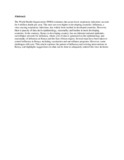| dc.contributor.author | Matheka, DM | |
| dc.contributor.author | Mokaya, J | |
| dc.contributor.author | Maritim, Marybeth C | |
| dc.date.accessioned | 2013-06-29T12:01:32Z | |
| dc.date.available | 2013-06-29T12:01:32Z | |
| dc.date.issued | 2013-04 | |
| dc.identifier.citation | Pan Afr Med J. 2013 Apr 8;14:138. doi: 10.11604/pamj.2013.14.138.2612. Print 2013. | en |
| dc.identifier.uri | http://www.ncbi.nlm.nih.gov/pmc/articles/PMC3683518/ | |
| dc.identifier.uri | http://erepository.uonbi.ac.ke:8080/xmlui/handle/123456789/42455 | |
| dc.description.abstract | The World Health Organization (WHO) estimates that acute lower respiratory infections account for 4 million deaths per year. The rates are even higher in developing countries. Influenza, a virus causing respiratory infections, has widely been studied in developed countries. However, there is paucity of data on its epidemiology, seasonality and burden in most developing countries. In the contrary, Kenya (a developing country) has an elaborate national epidemio-surveillance network for influenza, where a lot of data is generated on the epidemiology and seasonality of influenza in Kenya and the East African region. Several steps have been taken to control influenza in Kenya, including vaccination and surveillance programs. However, some challenges still exist. This article explores the pattern of influenza and existing interventions in Kenya, and highlights suggestions on what can be done to adequately control this virus in future. | en |
| dc.language.iso | en | en |
| dc.title | Overview Of Influenza Virus Infections In Kenya: Past, Present And Future | en |
| dc.type | Article | en |
| local.publisher | Department of MedicalphysioIology | en |


